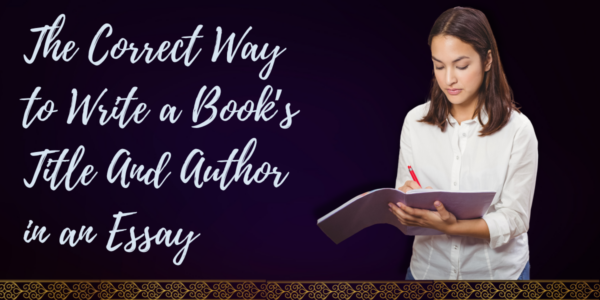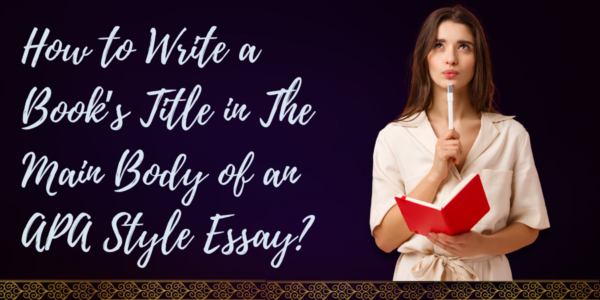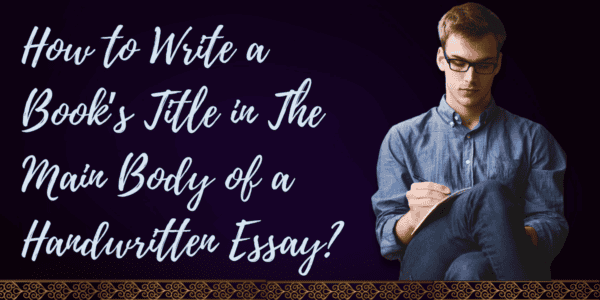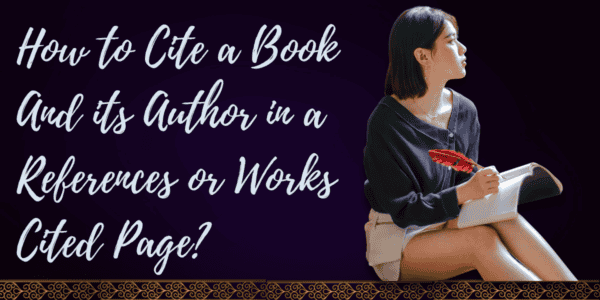So, you’re writing an essay, and you’re referencing a book. But how on earth do you write and cite the title and the author’s name correctly?
Do you use quotation marks? Italics? Punctuation? And what about capitalization?
The answer is a little more complicated than you might think. It all depends on the style of essay you’re writing, but once you’ve familiarized yourself with the rules for each one, it’s easy to mention and cite any book title and author’s name correctly, so you can get top marks from your instructor, each and every time.
The Correct Way to Write a Book’s Title And Author in an Essay

In this post, we’ll look at the three most common essay formats used in the US and learn how to properly display book titles and author names in each one.
The Most Popular Essay Formats
The three most commonly used essay formats found in schools, universities, and higher education institutions across America are known as APA, MLA, and Chicago style.
The format your professor assigns will depend on the subject matter, the department, the purpose of the essay, and the instructor’s individual preferences.
1. APA
APA stands for the American Psychological Association. This is the go-to format for scientific essays, including many social and behavioural sciences.
2. MLA
MLA stands for Modern Language Association and is the most frequently used format in humanities and liberal arts subjects, such as literature and history.
3. Chicago
Chicago format, also known as Turabian after its creator, Kate L. Turabian, is commonly used in the publishing world and also in subjects such as anthropology, history, and selected social sciences.
Why is Using The Correct Format so Important?
The short answer is that you’ll receive a lower grade if you don’t.
But of course, there are many good reasons why proper formatting is important when writing papers and essays.
1. Consistency
Formats like APA, MLA, and Chicago provide a strict set of criteria to stick to throughout an essay, ensuring consistency.
Consistency avoids confusion for the reader and helps them to quickly and easily identify what the writer is trying to say.
2. References And Research
Sticking with one style or format makes it easier for readers to check citations and conduct further research into the chosen topic.
3. Demonstrating Understanding
In academic settings, adhering to a particular style guide, such as APA, MLA, or Chicago, demonstrates your understanding of the rules and principles of written material within that field.
This shows that you don’t just understand the subject; you also know how to write about it.
4. Preparation For Future Studies
Suppose you’re a high school student or a college undergrad, familiarizing yourself with the basic principles of essay formatting. In that case, it is a great way to prepare yourself for your future academic pursuits, especially if you plan to progress onto a graduate or postgraduate program.
How to Write a Book’s Title in The Main Body of an APA Style Essay?

Here are the key rules to remember when writing book titles in the main body of an APA-style essay:
- Use quotation marks (not italics) on either side of the book’s title (with the exception of the holy texts like the Bible and reference works like dictionaries and almanacs).
- The first word of the title should be capitalized.
- All words and terms containing more than four letters or symbols should be capitalized.
- Any two-part words containing a hyphen should be capitalized.
- Words placed directly after a colon or dash should also be capitalized.
For example, “Slaughterhouse-Five”
How to Write a Book’s Title in The Main Body of an MLA or Chicago Style Essay?
MLA and Chicago-style essays use similar rules when it comes to mentioning book titles in the main body of an essay. Here are the key things to remember when using either of these formats:
- The book’s title should be displayed in italics (not quotation marks), with the exception of holy texts like the Bible.
- If the title contains punctuation, this should be italicized, too.
- All verbs, nouns, and adjectives should be capitalized.
- If you’re referring to a chapter or mentioning a book alongside the series it belongs to, use quotation marks, not italics.
For example,
One Flew Over the Cuckoo’s Nest by Ken Kesey, or “A Clash of Kings” from A Song of Ice and Fire by George R.R. Martin
1. Avoid Capitalizing Minor Words
Unless they appear as the first word in a title, the following words should be displayed in lowercase.
- Prepositions, such as on, in, at, and from.
- Articles, such as the, a, and an.
- Coordinating conjunctions, such as so, and, yet, but, and for.
This might sound a little complex at first, but it’s pretty simple and intuitive once you get the hang of it.
99% of the time, the book’s title as it is displayed on the front cover is correct for both MLA and Chicago-style essays.
How to Write a Book’s Title in The Main Body of a Handwritten Essay?

Handwritten essays used to be the norm, but these days, they’re most definitely the exception.
Still, there may be some instances where you’re asked to handwrite an essay rather than type it, in which case, you should follow the rules below.
1. Capitalization
The capitalization rules for writing book titles in the main body of a handwritten essay are the same as with typed essays.
So, if you’re handwriting an APA-style essay, make sure to capitalize the first letter of the first word in the title and do the same for every word containing more than four letters.
And when handwriting an MLA or Chicago-style essay, capitalize the first letter of the first word of the title and do the same for every word except for articles, prepositions, or coordinating conjunctions.
2. Underlining
No matter the format, book titles should always be underlined when handwriting an essay
- Underline the complete title, including any words that come after a colon or dash
- Underline any punctuation that appears in the book’s title
- Avoid underlining each word separately; always use one continuous line
- Make your line as straight as possible by using a ruler or following the line on the paper
How to Cite a Book And its Author in a References or Works Cited Page?

So, now you know how to write the title of a book mentioned in the body of an essay.
But what do you do when you need to cite a book and its author in your references or works cited page?
To keep it simple, I’ll use Lucy Maud Montgomery’s 1908 classic children’s novel, Anne of Green Gables, as an example for each essay style.
1. Book Citations in APA Style
Here’s the proper format for citing authors and their book titles in APA:
Last Name, First Names. (Year the book was published). Book title.
For example, Montgomery, Lucy Maud. (1908). Anne of Green Gables.
2. Book Citations in MLA Style
Here’s the proper format for citing authors and their book titles in MLA:
Last Name, First Names. Book title. City of Publication, Publisher, Year the book was published.
Note: You only need to include the city of publication if the book was published before 1900 or if the publisher is not based in the US.
For example, Montgomery, Lucy Maud. Anne of Green Gables. L.C. Page & Co., 1908.
3. Book Citations in Chicago Style
Here’s the proper format for citing authors and their book titles in Chicago style:
Last Name, First Names. Book Title: Subtitle. City of publication: Publisher, Year the book was published.
Note: Just like with MLA style, you only need to include the city of publication if the book was published before 1900 or if the publisher is not based in the US.
For example, Montgomery, Lucy Maud. Anne of Green Gables. L.C. Page & Co., 1908.
4. Book Citations in a Hand Written Essay
If you’re handwriting an essay, you’ll no doubt be handwriting your references or works cited page, too.
In this case, you should still follow the appropriate formatting rules above in relation to the chosen essay style.
But where a title appears in italics in a printed essay, in a handwritten essay, it should be neatly underlined instead.
Missing Information
If you’ve searched high and low for a book’s publisher, publication date, or the city in which it was published, but you still can’t find the information, it’s generally acceptable to leave it out.
Conclusion
Essay writing is a skill that takes practice, and at first, the rules and principles of the different formats can seem complex. This is especially true when you’re writing about books and their authors or citing other people’s work.
But hopefully, this post has helped explain the structures used in each of the most commonly used formats so that next time you write an essay, you can be confident that you’re doing it right.



